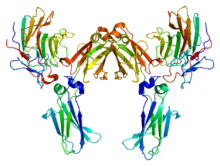Intracellular antibody-mediated degradation
(Redirected from
Intracellular antibody-mediated proteolysis
)Intracellular antibody-mediated degradation (IAMD) is a neutralization mechanism of intracellular
adenovirus[1]
but is likely to also be effective against other non-enveloped viruses.
Mechanism of action

In IAMD, the neutralization of the pathogen follows a non-cytotoxic mechanism.Antibody-dependent cell-mediated cytotoxicity, instead the virions are rapidly destroyed and the cell may be relieved of infection.
- Immunoglobulin G (IgG) binds specifically to the target antigen presented on the pathogen extracellularly
- The antibody bound pathogen infects a host cell
- In the cytosol, TRIM21 (a protein of the Tripartite motif family) binds with high affinity to IgG
- TRIM21 is conjugated with ubiquitin, which directs the complex to the proteasome
- Degradation by proteolysis of both the protein capsid and the antibody occurs, but not the TRIM21 protein
Resistance to mutants
There are a number of reasons why IAMD is so resistant to evasion by mutants through evolution:
- The targeting of pathogens by antibodies is adaptive while the degradation is innate; the overall response therefore combines both adaptive and innate immunity.
- The proteasomal targeting is mediated by the autoubiquitination of TRIM21, there is no direct interaction with the pathogen[1] so mutants which evade ubiquitination themselves cannot evade IAMD.
- Unlike extracellular humoral immune responses, this intracellular mechanism is expressed in most human tissues[1] and is an example of encapsulating immunity as opposed to mere immune surveillance.
